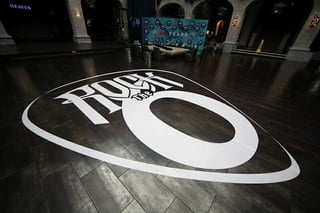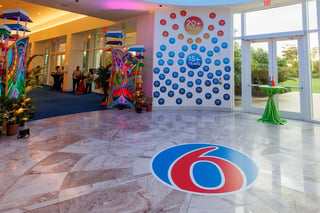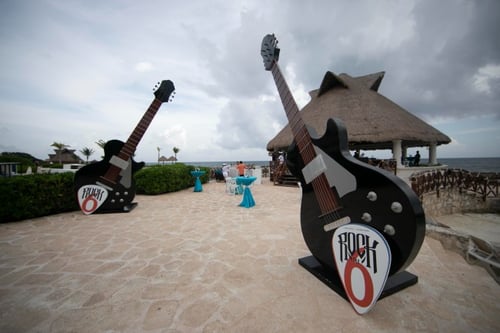Imagine attendees embarking on a journey of creativity, innovation, and brand immersion as soon as they enter an event. We here at Bishop-McCann are constantly looking for ways to turn a guest’s head. We’ve wrapped entire walls with branding, created greenery walls, projected cityscapes onto every wall in a room to simulate travel, and even wrapped buses. Why? Because guests are always blown away by ingenious, eye-catching designs embedded into every nook and cranny of a venue. You transform the physical event space into a memorable brand experience by using environmental branding, and the results are stunning.
Environmental branding offers a unique opportunity to showcase your brand’s identity, values, and story in a truly impactful way. From incorporating brand colors and imagery into décor elements to designing interactive installations to tell a story, you can create engaging environments that resonate on a deeper level.
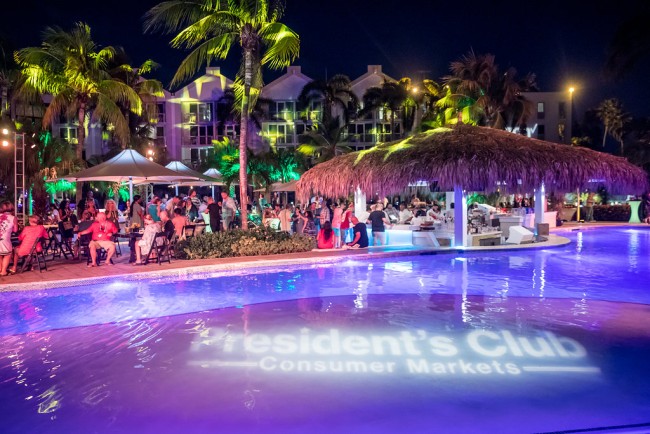
Quick Links
- What Is Event Branding?
- The Relationship Between Event Branding and Attendee Experience
- What Are the Elements of Branding?
- What Is Environmental Branding?
- Nine Creative Environmental Branding Examples
What Is Event Branding?
Much of what companies focus on is branding and marketing. The goal is to connect your brand to values, feelings, and your audience, including your employees. Event branding is no different.
In other words, event branding is the strategic development and application of visual and experiential activations to create a unique and memorable identity for your corporate event. And if more than 80% of event planners report that events are an effective marketing tactic, then it’s worth prioritizing your branding strategy.
Obviously, event branding should reflect your brand and its values. However, you should also reinforce the message of the event itself. Every aspect of your program, from invitations and initial marketing materials to the event environment, is an opportunity to make an impression on your guests.
By utilizing event branding, planners can reinforce brand identity, enhance brand recognition, and ensure an impactful experience for attendees. But first, you must understand your event and its goals to create successful and cohesive branding for your event.
The Relationship Between Event Branding and Attendee Experience
After any event, the focus becomes whether or not the event was successful. To make that determination, you’ll want to consider attendee experience and satisfaction. Fortunately, branding contributes to an overall positive attendee experience. It also ensures that your brand is associated with the positive memories attendees will take home.
From the name of your event to creatively using existing elements of your branding, your event has the potential to shape how your attendees feel about and perceive your business moving forward. As a result, effective event branding goes beyond aesthetics; it shapes the overall experience for attendees.
When branding is seamlessly integrated into various components, from registration materials to stage design, it fosters a cohesive and polished atmosphere. A well-branded event cultivates a sense of professionalism, trust, and authenticity, which can significantly impact attendee satisfaction.
This can begin the second attendees step foot inside the venue by incorporating themed features that also tie in the destination of the event – such as giving leis in Hawaii, being welcomed by flamenco dancers and live music from a local band in Spain, or getting greeted at registration by flamingos in the Caribbean (we’ve done this ourselves, and attendees loved it!). These details make any event unique, and they are especially appreciated during registration, which adds an extra layer of fun to a necessary organizational task.
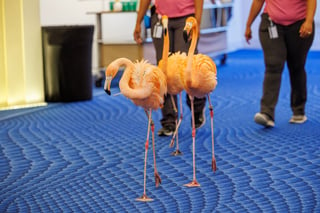
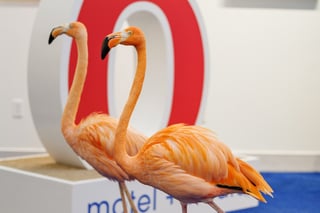
All of these factors contribute to positive post-event feedback and potentially foster long-term relationships between the company and its audience. In essence, the synergy between event branding and attendee experience is a critical aspect of creating successful and impactful corporate events.
What Are the Elements of Branding?
There are multiple components that go into branding, from your logo to the tone you choose to use. So when we look at the elements that make up a brand, look for ways these aspects can be included in your event.
The elements of branding to consider include:
1. Logo - Many brands are recognized by their logo alone. When your customers immediately know your business just by viewing your logo, you’ve reached the pinnacle of successful branding.
2. Colors - Consider some of your favorite brands, and you’ll likely recognize their color palette. These hues often become synonymous with the logo and company.
3. Shapes - Perhaps slightly less recognized than logo and color palette, shapes are an equally fundamental element of brand design and visual appeal. Shapes are used to create various patterns and graphic assets that lend themselves to certain products; even a silhouette can convey a clear message about a product or brand.
4. Fonts - Fonts are an essential design element of a brand. Much like shapes, font elements convey tone and feeling. It’s the reason no one sends business emails in Comic Sans. Your font reflects your brand’s personality, which can then be showcased at your event.
5. Imagery - The final piece needed to build your brand and share your message is imagery. Remember, you want to communicate the right message to your target audience, so select your visuals carefully. For example, when Bishop-McCann produced a “Reach the Beach” event and a “Route 6” (a play on Route 66 for Motel 6) conference, imagery was key. Visuals that reflected tropical destinations were used throughout “Reach the Beach” while iconic roadside attractions and signs were utilized in “Route 6.” Having well-defined imagery will ensure your event is memorable.
6. Tone/Voice/Language - Once you’ve considered the visual appeal of your brand, it’s important to also consider the language you choose and the tone. There are a few iconic examples that brands have carefully chosen. “Just do it” implies grit and tenacity, a perspective Nike intentionally chose to reflect their brand. Remember words, not just visual elements, set the tone and represent your brand’s unique perspective.
7. Tagline - From “You’re in good hands” to “The happiest place on earth,” brands with strong taglines are often recognized by their words. If your brand has such a tagline, consider how it might play into your event theme. Perhaps, a slight change could create something new and creative for your event while still leveraging the familiarity of the tagline.
8. Positioning - Positioning refers to how you appear in the market and the value proposition you want to present to customers or clients. Brands that successfully position themselves in their ideal market see increased customer loyalty and revenue. Because this is so important, ensure you focus on your differentiating aspects. Set your brand apart from your competitors.
Piecing all of this together into an effective branding strategy will help event planners drive home the message of your corporate event. And, if done right, it creates a memorable experience that attendees will love.
What Is Environmental Branding?
Though it’s common to hand out swag bags with branded water bottles, sunglasses, and pens, event planners can push the boundaries of event branding by extending their reach and thinking bigger.
Environmental branding provides a unique and interesting way to incorporate aspects of your brand into any event. By mixing elements of visual branding with architectural aspects of existing structures and interior design, environmental branding can drive home messages from a keynote session or even excite attendees about activities. It’s also a perfect chance to provide brand exposure for program sponsors.
Often, environmental branding provides photo opportunities for attendees who can then post to their social media accounts, creating additional exposure for your brand and event. This approach goes beyond traditional signage, extending to the entire spatial experience, from entrance areas and stages to breakout sessions, effectively shaping the perception of the brand and enhancing the overall impact of the event on participants. Plus, environmental branding allows event organizers to ensure all elements of the event are captivating, which in turn boosts attendee engagement.
Bishop-McCann loves utilizing environmental branding to immerse guests in an event, and site visits are an excellent way to ensure you get the most out of your space. By getting a first-hand look at the venue before the event, designers can plan creative ways to turn the venue into a truly immersive experience for guests.
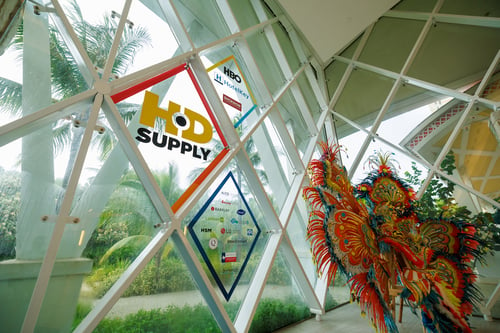
For a recent program in the Bahamas, we began taking notes on the site visit (as any good planner will do), looking for branding opportunities. We also noticed many existing elements, such as fish-scale patterns in the carpet, diamond-shaped windows giving a stained glass window effect, and paint colors that could be incorporated into creative elements. We then created the logo to reflect these elements and noted all areas that could be branded for the most visual impact. Using a space creatively always adds value to the program.
Nine Creative Environmental Branding Examples
At Bishop-McCann, we love it when a venue provides unique opportunities for environmental branding, and it’s something our designers note when considering venues for a corporate event. Here’s a look at a few creative ways to incorporate environmental branding into event experiences:
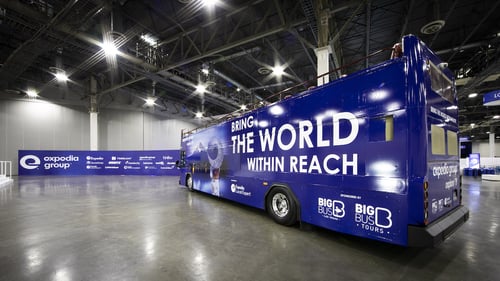
Transportation
Chartering a bus to your venue? You can impress your attendees by ensuring they arrive in a customized bus or van that’s decked out in the event branding materials. These buses can be personalized with your company's branding elements using window clings, turning them into moving extensions of the event's visual identity.
Utilizing branded charter buses not only provides a distinctive and cohesive presence during transportation but also turns the journey into an immersive brand experience for attendees. This innovative form of environmental branding ensures that the company's image is consistently reinforced as participants travel to and from event venues, making a memorable and lasting impression that extends beyond the traditional event space.
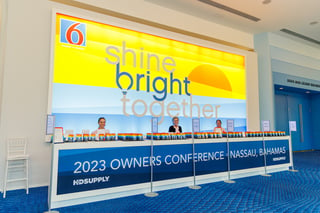
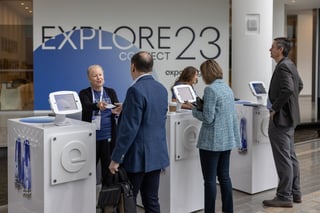
Branded Check-in Desks
After arriving, you can extend the environmental branding from the transportation to the check-in or registration desks. This guarantees that from the first moment your attendees interact with event staff, your brand and message are a focal point. Plus, this is an excellent way to greet your guests, establish a visually unified space, and help build excitement for what’s to come.
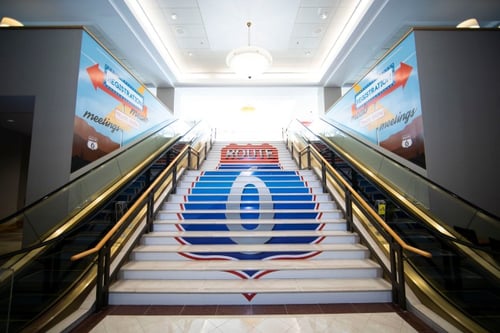
Stair Wraps
Branded steps are an attendee favorite. Whether it’s the entrance to the event or deeper within the venue itself, stair wraps immediately set a tone and highlight your brand.
Further, they’re an eye-catching visual from several angles, which means they’re perfect for photo opportunities and selfies to be shared on social media channels. Most attendees aren’t expecting steps to be branded, so it’s an opportunity to utilize unusual branding space that will garner attention.
Oversized Floor Clings
One of the best parts of environmental branding is how visually striking these elements are and how they circumvent traditional space constraints. Take floor clings for example. These clings can occupy a large space, promoting your brand and creating unique photo opportunities – the bigger the branding, the better.
Additionally, floor clings can be functional as well. By incorporating arrows, they can help direct traffic. Another creative use is to add floor clings in an elevator, so attendees begin thinking about your event before they even arrive. We have even used the floor clings to highlight attendee winners creating a walk of fame effect; the attendees loved finding their cling to signify their recent accomplishment.
When planning these elements, be sure to take into consideration if the hotel or venue flooring has a design or pattern as that can help to dictate the overall shape and visuals for the clings, in addition to their placement.
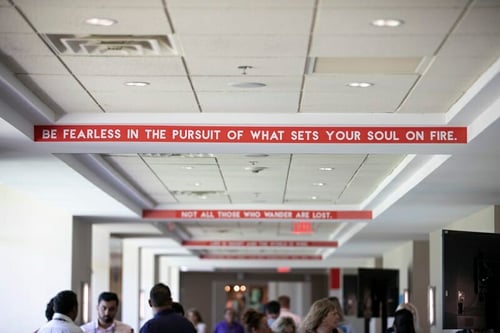
Ceiling Soffit Clings
Looking for a way to enhance your event theme while your attendees are on the go? If there are multiple soffits in a row at your venue, this is a perfect opportunity to present messaging to support your theme, since attendees will be able to read your messaging while walking to their destination (whether that is a keynote session, entertainment, or simply discussion spaces).
Be purposeful—make sure your message ties in with the event theme to help drive home your desired communication.
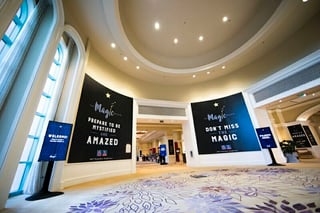
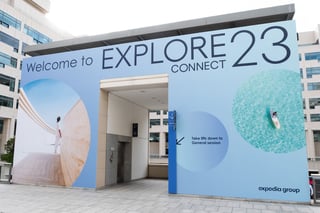
Wall and Window Clings
Picture attendees walking through an entrance, enhanced by larger-than-life wall clings. This gateway to registration truly suggests that attendees have arrived at your corporate event and helps to immediately immerse them in the event experience.
Columns also present a great opportunity for wall clings, and you could hang elevated banners in a space that enables attendees to read messaging from a distance. Plus, these banners can be viewed even when a large crowd is gathering in the space below.
Further, these elements could be added to windows, which can transform the space. The point is, every corner can be transformed by adding unique graphics that personalize the space for your event.
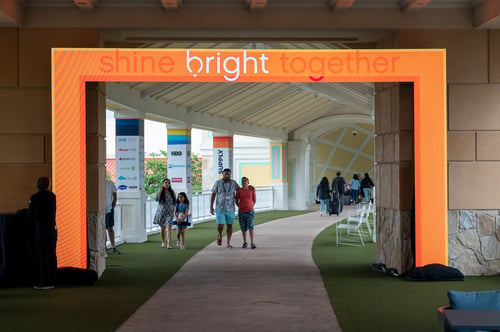
LED Arches
Looking for something a bit more dynamic? LED arches allow event organizers to display graphics and videos on screens throughout the venue. This method of environmental branding means you can play messages, highlight event sponsors, welcome guests, and more – all while using brand elements and themes. Plus, you won’t be limited to a single static image so the graphic can change over the course of the event.
Giant 3D Letters or Event Logos
Installation pieces, especially those that wisely use or enhance a space, make a lasting impression. Similarly, giant installations (such as 3D logos, taglines, or single words that capture your event theme) also lend themselves to amazing photo opportunities.
For example, a giant guitar that fits with an overall rock and roll theme could welcome guests onto your property. This might be the perfect opportunity to bring out the creative, fun side of attendees.
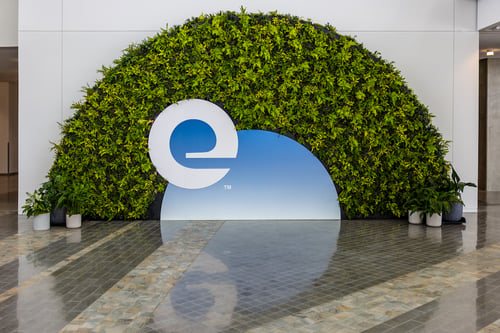
Greenery Wall
When it comes to environmental branding, why not turn to the environment for inspiration? Greenery walls can bring the outside in, transforming the aesthetics of the space to match the surrounding nature. In fact, when we did this for Expedia in 2023, the wall immediately became not just a beautiful element but also a memorable photo op that was used often during the conference.
When reviewing environmental branding opportunities, the goal is to craft personalized, unique, and memorable experiences. So, try to find hotels or venues that provide branding situations that will stop attendees in their tracks. Branding in locations that make guests pause to take in the graphics because they didn’t expect them or because they are visually appealing are perfect photo ops for your audience. Plus these stunning elements can turn into a creative way to recognize winners at your event.
Also, look for areas where your attendees might need assistance. Then, use your branding to create visuals to provide needed direction, whether that be signage that points out the registration desk or floor clings that direct traffic. Put yourself in the attendee’s shoes when walking around the space to determine where these types of visuals might be used.
At Bishop-McCann, we love looking at spaces through a creative lens and finding ways to utilize unique branding opportunities to enhance an attendee’s event experience. While it starts at the planning stage, environmental branding is an essential part of this process. If you’re looking for help with creative branding at your next event, let’s talk today!

